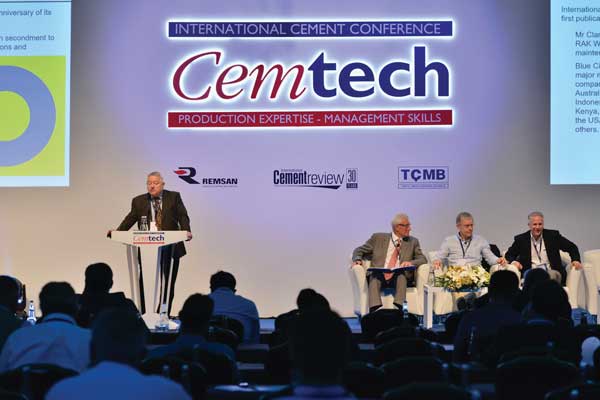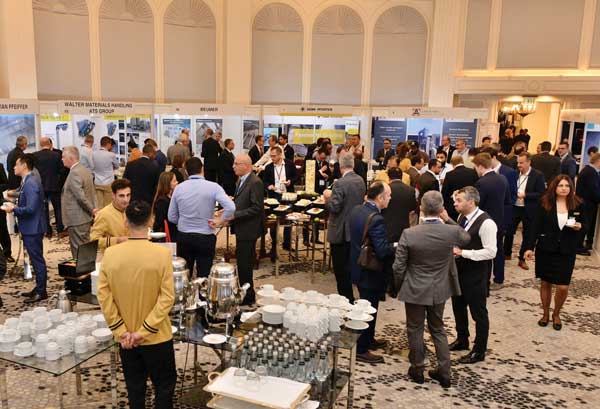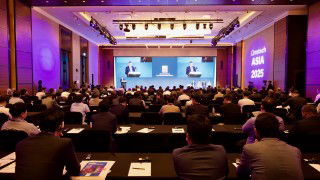Cemtech Europe 2018 was held at the Conrad Istanbul Bosphorus, Turkey, on 14-17 October. Over 200 delegates from the global cement industry gathered for the conference which celebrated the local industry of Turkey and the wider European region.

Cemtech Europe 2018’s conference programme featured a range of
international reports and manufacturing technology case studies
International Cement Review’s Managing Editor, Thomas Armstrong, inaugurated Cemtech Europe 2018 by welcoming delegates to Turkey. Mr Armstrong noted how the industry’s lower capacity utilisation levels worldwide, combined with increasingly urgent environmental pressures, are shaping the industry landscape. The conference agenda would provide cement producers with the know-how and inspiration to successfully improve efficiency levels and address climate change issues at a plant level.
Conference programme
Market reports and trends
The first morning of the conference continued with an opening speech by the Turkish Cement Manufacturers’ Association’s Head of Economic Evaluations and Foreign Relations, Kerem Erşen, who introduced the cement market of the country. Mr Erşen celebrated the success of the Turkish economy, which saw 6.7 per cent GDP growth in the 1H18. Furthermore, its cement industry recorded a 7.7 per cent increase in production in 2017. This is expected to rise by 3-4 per cent per annum in 2019-23 on the back of positive developments in the housing, infrastructure and energy sectors. Capacity is expected to surge to 88Mta in 2018, following the completion of two greenfield (Soma and Arkoz) and two brownfield projects (Batisöke and Ankara).

Dalmia Cement’s Ashwani Pahuja
presented a keynote address
Ashwani Pahuja, Dalmia Cement (India), presented a keynote address on sustainable cement manufacturing. Mr Pahuja began his outlook by stating how the company’s efforts had resulted in the avoidance of 17.6Mt of carbon emissions over the past five years.
As part of its ambition to deliver low-carbon cement manufacturing, Dalmia has increased its use of alternative raw materials (ARMs) to 6Mt in FY18 from 1Mt in FY13. As a result of actions such as these, its carbon footprint sits 40 per cent lower than the global average for cement companies. In addition, Dalmia Cement intends to become carbon negative by 2040.
Jean-Christophe Lefèvre-Moulenq, CM-CIC Market Solutions (France), spoke about how the supremacy of the European ‘Big Five’ major cement producers is now being challenged by multiple emerging market players around the world. He suggested how this could result in countries such as China and Turkey playing a larger role in the global industry, perhaps even by taking advantage of divested assets and expanding into Africa and across Europe.
Peter Hoddinott, independent consultant (UK), looked at procurement strategies within established companies. An essential element within the structure of a business, the procurement team should be full of talented, innovative members who can tailor the right approach to an issue, he explained. For example, non-critical or routine purchases can be outsourced, saving time to source global contracts and develop supplier relations. A successful procurement strategy will result in improved EBITDA and could even turn losses into profit-generating solutions.
Sabia’s Tom Dannemiller (USA) explained how we are in the midst of the Fourth Industrial Revolution, with digital transformations now a practical reality for cement plants. The company offers its Sage tool, which can support plants in identifying anomalies in their data, therefore helping them preempt an issue before an unplanned shutdown has occured. Other Industry 4.0 solutions, such as the creation of a digital twin of a cement plant, are designed to replicate facilities and simulate appropriate solutions to issues the plant may be facing.
ICR’s Technical Consultant and founder of Whitehopleman (UK), Michael Clark, took the opportunity to speak about the past 30 years of the magazine and the industry developments that have taken place in that time.
The day continued with a discussion on cement and clinker flows within the Mediterranean by Sylvie Doutres, DSG Consultants (France), with a significant 60 per cent of clinker exported from the European/Mediterranean region transported to Africa. In 2018 maritime exports from Turkey and southern Europe will remain relatively stable, while exports from Tunisia and Algeria are set to strengthen.
Jim O’Brien, Jim O’Brien CSR Consulting (Ireland), provided an overview of the global aggregates industry. As a result of the 2008 global recession approximately 700Mt of aggregate production was lost between 2008-13. However, some countries have now entered a recovery phase. To continue this growth, the industry has a number of priorities to consider such as curbing illegal quarrying and optimising transport to market.
Hamid Reza Tajik of Iran’s Cement Industry Export Development Co bridged the gap between market reports and technical presentations by both focussing on the Iranian cement industry and introducing GPS/GSM systems, which are deployed in quarries to reduce the quality fluctuation of raw materials. Iran’s cement industry currently has 83Mta of capacity with a utilisation rate of 68 per cent. This is forecast to expand by almost 40Mta to 120Mta by 2025.
As the programme moved beyond prevailing market trends and economic overviews, Nuh Çimento’s Ilker Avci (Turkey) presented a case study of the recent grinding and pyroprocessing upgrades undertaken at its facility in Hereke. Delegates later had the chance to see the upgrades by visiting the plant.
Alternative fuel applications
Basri Ogut, Walter Materials Handling/ATS Group (France), introduced the alternative fuel session by looking at three recent examples where the company’s solutions were implemented to feed AFs into the production process.
Tim Hamer, Vecoplan (Germany), highlighted the company’s new AF shredding solutions that have helped a RDF production line in Turkey achieve a throughput of 35tph.
Matthias Mersmann of aixergee (Germany) presented a successful case study of the optimisation of a secondary-fuel-fired calciner. Creating a digital twin of the calciner and modelling it through the application of computational fluid dynamics (CFD) can help the user find the root cause of issues resulting from secondary-fuel use. The digital model can also be adapted until a solution to the problem is found, which can then be actioned on the real calciner.
Moving into the second day, the final session on AFs began with a presentation by Oral Türesay, KHD (Germany), on the company’s latest developments regarding AF burning. It achieves high AF utilisation rates through the application of its suite of products, including Pyro-Jet® kiln burner, Pyroclon-R®calciner and Pyrorotor®. The company is currently carrying out Pyrorotor projects in Turkey, China and South Korea.
Nuh Çimento (Turkey) highlighted how EES Services’ (Mexico) Mg-based sulphur control agent had assisted in the use of high-sulphur petcoke in the combustion process, ultimately reducing material build-up in the kiln and allowing longer production runs.
Meanwhile, Michal Hrala of Beumer (Germany) looked at a case study where the company had provided a low-energy method of conveying AFs for Denizli Çimento. This project was covered in detail within the ICR October 2018 issue.
Manufacturing technology
Schenck Process’ Mesut Akbulut (Germany) explored the company’s weighing and feeding solutions for the industry, including the Flexibel weighfeeder, bypass dust handling system and LOGiQ® transport automation process. The LOGiQ system automates the delivery procedure at a cement plant, thereby increasing efficiency and allowing 24/7 operation on a self-service basis.
Firat Aslan of Dal Teknik Makina (Turkey) detailed the products and services offered in its filter-to-filter pyroprocess design. As part of this, the company offers a kiln/VRM dedusting unit, raw meal transport, kiln feeding unit, gas conditioning tower, full pyroprocess system (preheater, rotary kiln and cooler) and clinker cooler dedusting equipment.
Juliano Arantes, ABB (Switzerland), and Ali Firat, Traçim (Turkey), presented a case study on the ABB AbilityTM Expert Optimizer and its application at the cement producer’s Kirklareli facility. The optimisation project was carried out on its pyroprocessing line and the results showed that the system successfully regulated calciner temperature, increased kiln sensitivity to changes in raw material quality and stabilised grate speed in the cooler.
Ullrich Speer of Lechler (Germany) presented the range of applications for the company’s spray nozzle solutions in cement plants, including gas cooling, high-efficiency selective non-catalytic reduction (heSNCR) and dust suppression.
Nijat Orujov, VDZ (Germany), started the grinding session by delivering a presentation on the optimisation of ball mills, which can be achieved through mill audits and process analysis to determine areas for improvement. Following this with a look at optimisation in VRMs, Roland Martini of Gebr Pfeiffer (Germany) considered factors such as operating the units without external heat, reduced water injection and the adjustment of cement quality while grinding.
Mr Martini finished by providing operational results from a unit in Port Kembla, Australia, which has a higher throughput and lower specific energy consumption than initially guaranteed. Yannic Sesemann, Köppern (Germany), concluded the session by examining the implementation of a high-pressure grinding roll (HPGR) in a Slovakian cement plant.
Joel Maia, FCT Combustion (Germany), considered how the company’s new Turbo-FlexTM burner could maximise alternative fuel firing. The product employs two separate burner arrangements, a standard mode and AF boost mode, offering flexibility between fuel sources and optimised flames for both. The company’s first Turbo-Flex burner is currently in operation in Europe, firing 80 per cent RDF, petcoke and liquid AF.
Vahid Mirsaiidi, Auburn FilterSense (USA), examined baghouse compliance monitoring through the application of its B-PacTM PRO ES system. It streamlines production by integrating particle monitoring and automating baghouse processes. By using Aumund’s baghouse solutions, a Buzzi Unicem facility in the USA achieved US-EPA NESHAP compliance and sent automated reports.
Nick Sutherland, Welding Alloys Group (UK), finished the presentation programme by showing the company’s latest wear-resistant welding technology for VRMs. MillCarbTM is a repairable welded overlay that substantially increases the wear life of grinding components.
Plant tour
The Cemtech Europe plant tour took place at Nuh Çimento’s Hereke facility, strategically located on the Turkish coastline. As one of the largest production facilities in the country, the comprehensive tour allowed visitors to explore each of its three production lines. The plant had recently completed extensive modernisation works to its pyroprocessing line and grinding mills. DAL Engineering increased the capacity of Line 1 from 2750tpd to a guaranteed 3200tpd by installing new cyclones amongst other upgrades. Meanwhile, KHD Humboldt Wedag delivered and installed two Comflex® SC16-3250 clinker grinding units, which join Turkey’s largest ball mill as the grinding systems used by the plant.
Extended programme
The event featured a 26-stand exhibition, with a hospitality suite organised by Remsan. The exhibition allowed delegates to communicate directly with equipment suppliers to find the best manufacturing solutions.

The 26-stand exhibition gave equipment suppliers the chance to communicate with producers
To celebrate the conclusion of another successful Cemtech conference, a Gala Dinner was held and supported by a variety of local entertainment.
Next event
Cemtech Middle East & Africa takes place at the Grand Hyatt Dubai, UAE, on 17-20 February 2019.
This article was first published in International Cement Review in December 2018.
